Andalusia Cycling Routes & Travel Guide
A cycling guide to Andalusia’s valleys, plateaus, and cultural highlights, combining steady riding, warm conditions, and authentic southern Spain.
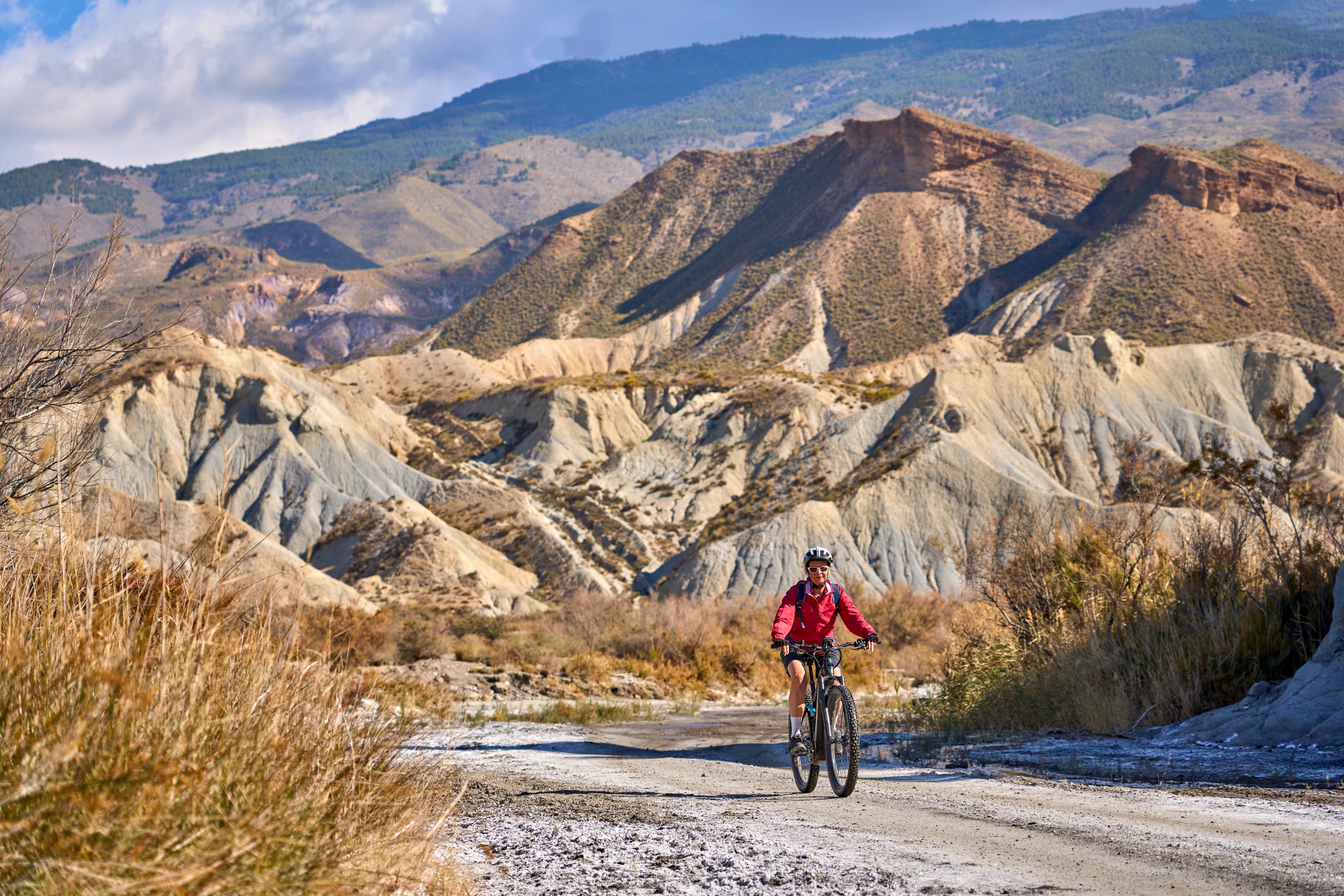
Quick Links
Andalusia stands out as one of Spain’s most distinctive cycling landscapes, defined by endless olive groves, hilltop villages, and deep Iberian–Moorish heritage. Many of its natural and cultural sites lie within short reach, the terrain stays largely rolling, and the climate allows for an exceptionally long riding season.

What You Need to Know at a Glance
- Region type: One of Spain’s most historic and culturally distinctive regions, shaped by Roman, Moorish, and Christian legacies
- Main hubs: Seville, Málaga, Córdoba, Granada, Cádiz, Almería, Jaén
- Key landscapes: Olive-grove plateaus, the Guadalquivir valley, Subbética and Baetic foothills, Mediterranean and Atlantic coastlines, white-village sierras
- Climate: Long, hot summers; mild winters; pronounced temperature differences between lowlands and mountain areas
- Heritage: World-renowned monuments including the Alhambra, Mezquita-Cathedral, Alcázar of Seville, and dozens of UNESCO-listed sites
- Character: A blend of Andalusi, Mediterranean, and rural mountain traditions expressed through architecture, gastronomy, and music
- Best time to go: March–June & September–November for comfortable weather and active cultural calendars
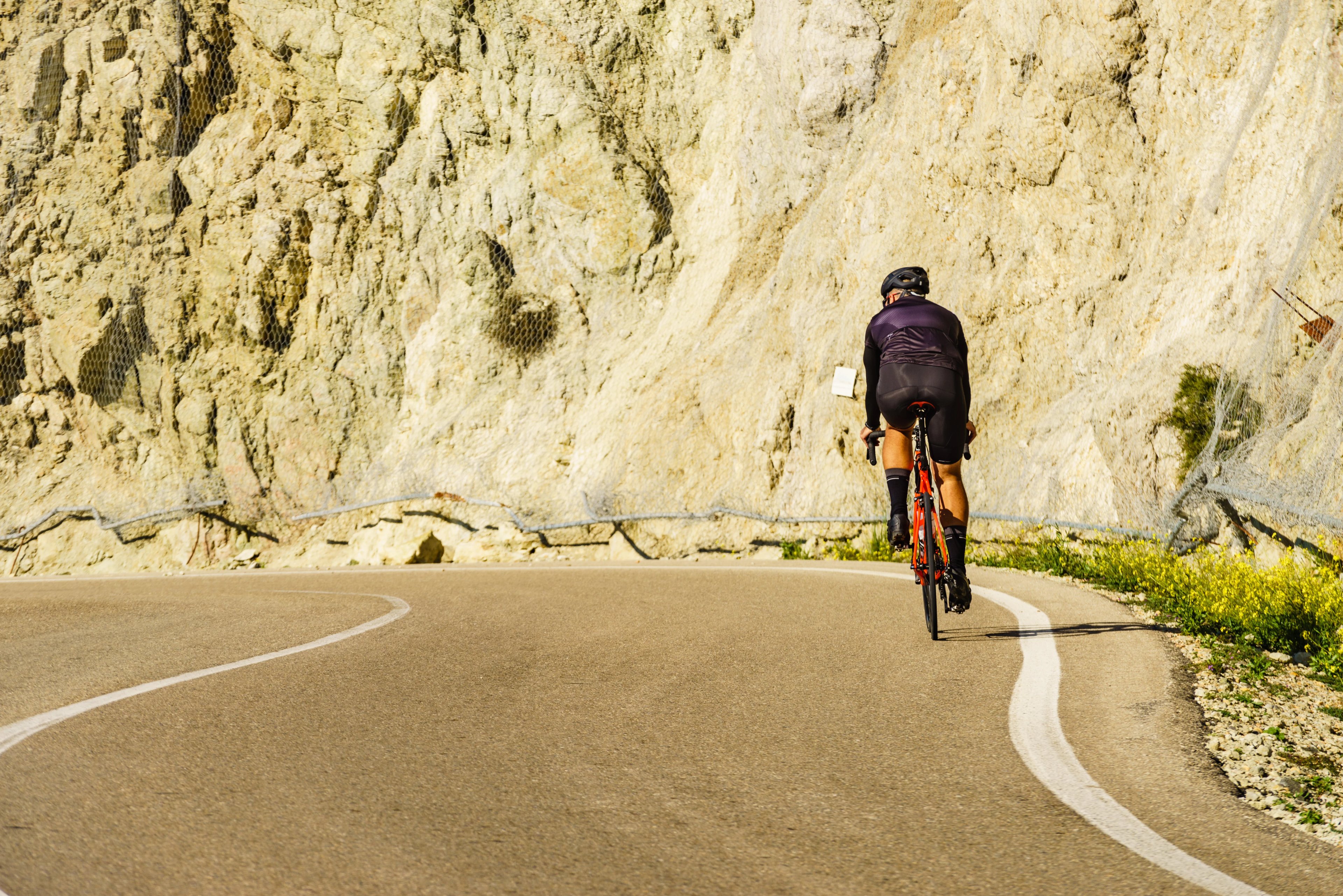
Most well-known cycling regions revolve around a single signature route, but Andalusia stands out precisely because it doesn’t. Instead, it offers a broad, varied network of river-valley greenways, former railway lines, and quiet rural connections linking historic towns across the Guadalquivir basin and surrounding sierras. This diversity creates space for easy plateau rides as well as more committed days in the limestone highlands.
What to Expect When Cycling
Routes in Andalusia follow a predictable rhythm: steady riding on quiet rural lanes, short climbs that unfold near town limits, and long stretches of open countryside with clear views in all directions.
Town spacing is convenient, meaning regular access to shade, water, and food even on hotter days. Infrastructure is improving each year, with Via Verde corridors adding traffic-free alternatives to traditional rural roads.
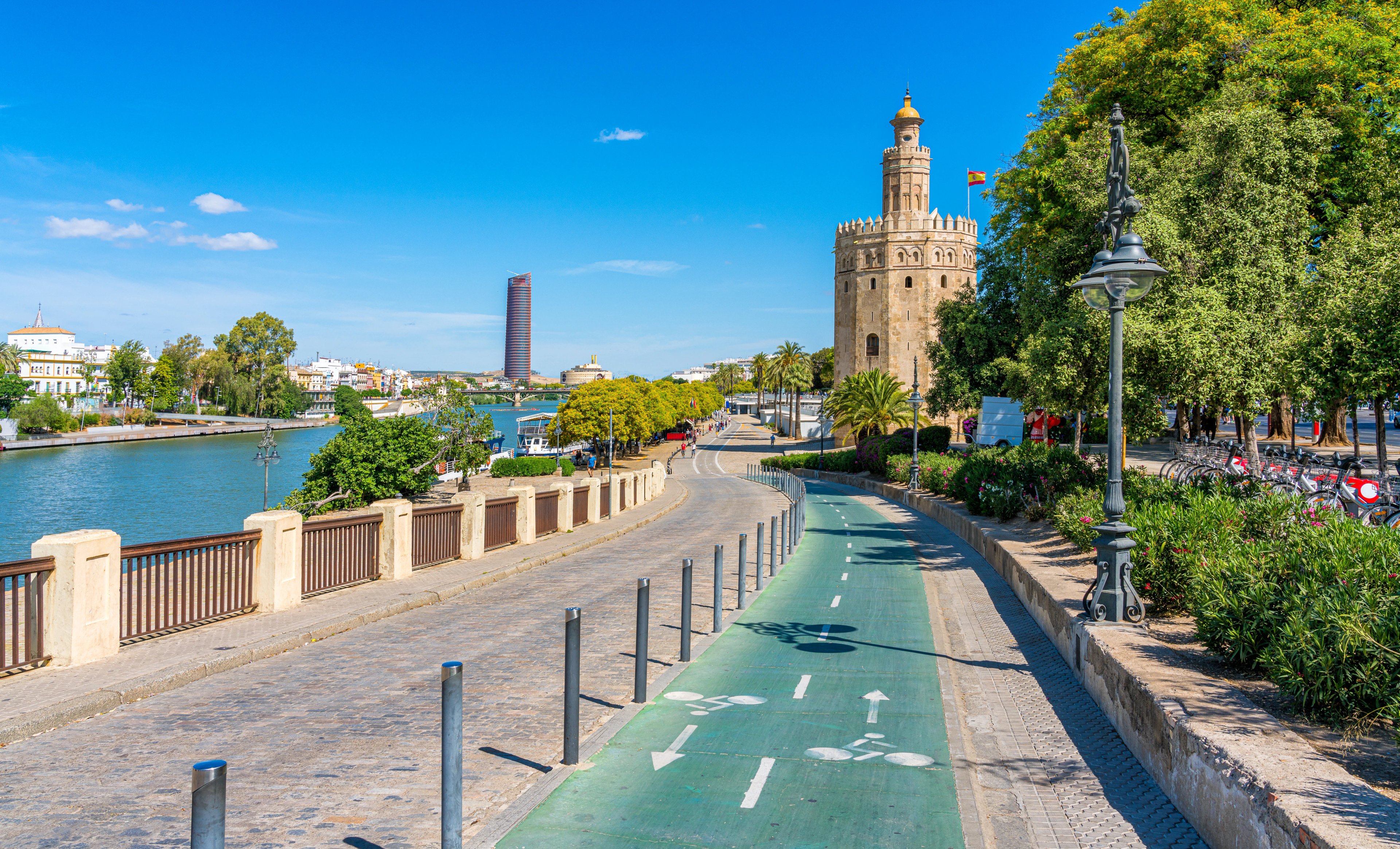
- Daily distance: Recommended 40–70 kilometers for a versatile experience, but shorter distances are possible too
- Elevation: The paved road reaches approximately 3,398 meters, making it the highest paved cycling ascent in Europe.
- Wind: Inland breezes are typically mild; coastal and western zones can be windier
- Traffic levels: Low on agricultural roads; moderate when approaching larger towns
- Signage: Generally consistent on major regional roads and greenways, with less coverage on remote rural lanes
Bike-friendly Amenities on the Road
- Potable water: Public fountains with drinking water are common in towns; fewer in the open countryside
- Food & cafés: Most villages offer at least one café-bar or bakery for mid-ride breaks
- Road quality: Generally well-maintained secondary roads; occasional rough patches on older rural lanes
- Bike services: Widely available in larger cities such as Seville, Málaga, Córdoba, and Granada, while rural areas offer more basic repair and rental options
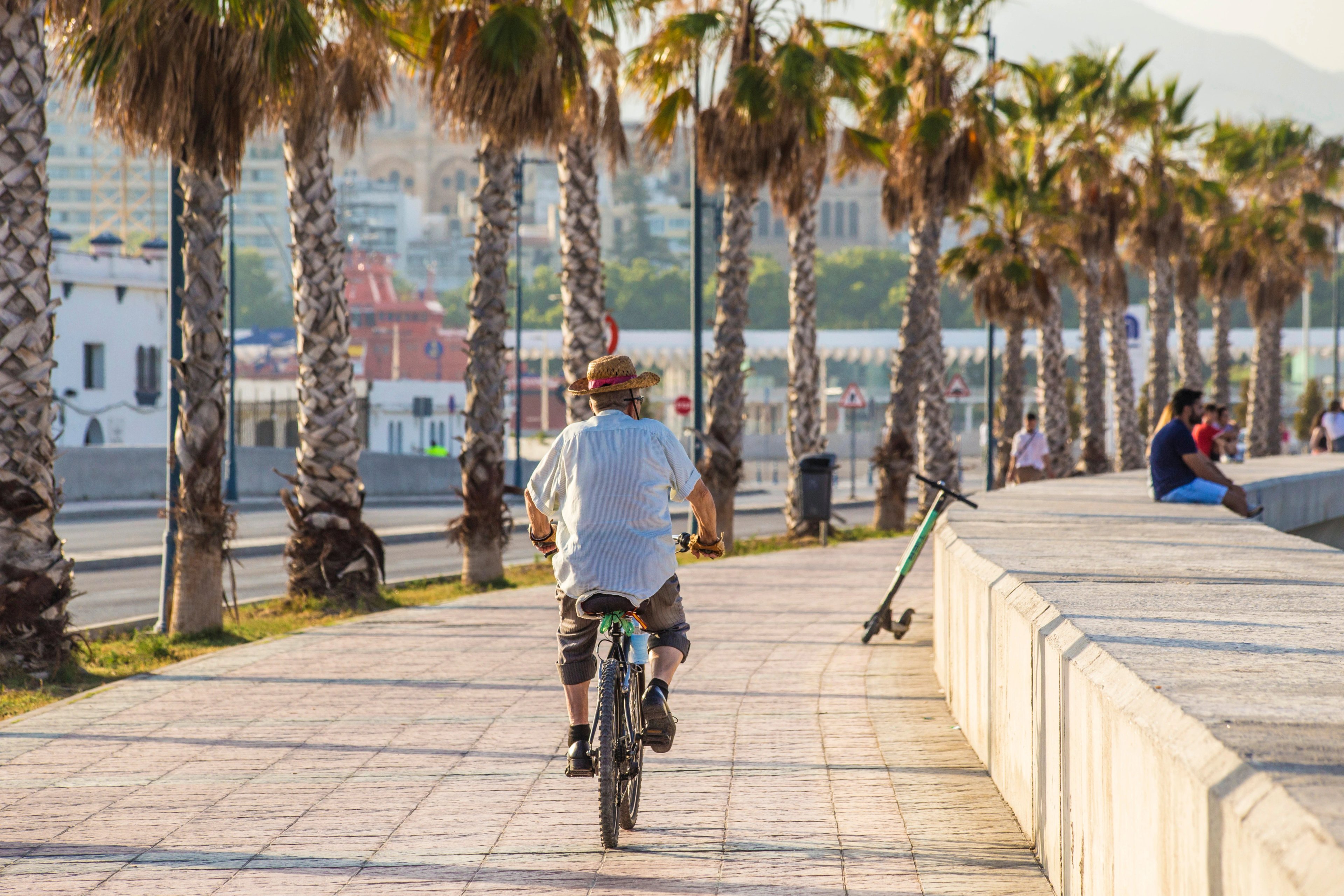
Who It’s For?
Andalusia works well for a wide range of cyclists thanks to its manageable distances, rolling terrain, and dense network of towns that create natural breaks throughout the day. Sierra foothills allow for optional elevation gains, while greenways and river valleys keep most routes approachable.
- Leisure cyclists benefit from short town-to-town links (often 15–25 kilometers) and steady rural lanes that avoid heavy traffic
- Intermediate riders enjoy frequent shirt, rewarding climbs in the Subbética and Aracena foothills, adding variety without demanding alpine-level fitness
- E-bike users get reliable gradients, warm weather, and plenty of villages to recharge both bikes and riders on longer days
- Cultural travelers have access to UNESCO cities, white villages, and historic olive-mill towns positioned within easy reach of each other
- Gravel riders find consistent mixed-surface riding on Vías Verdes, river embankments, and agricultural service lanes
- Fitness-focused cyclists can incorporate tougher Sierra extensions, including segments rising toward the Sierra Nevada fringes or classic local climbs such as Puerto del Sol (1,100 m) and Puerto de Zafarraya (approx. 900 m)
- Small groups and couples appreciate the flexible logistics and route options that allow different abilities to share the same base without compromising daily enjoyment
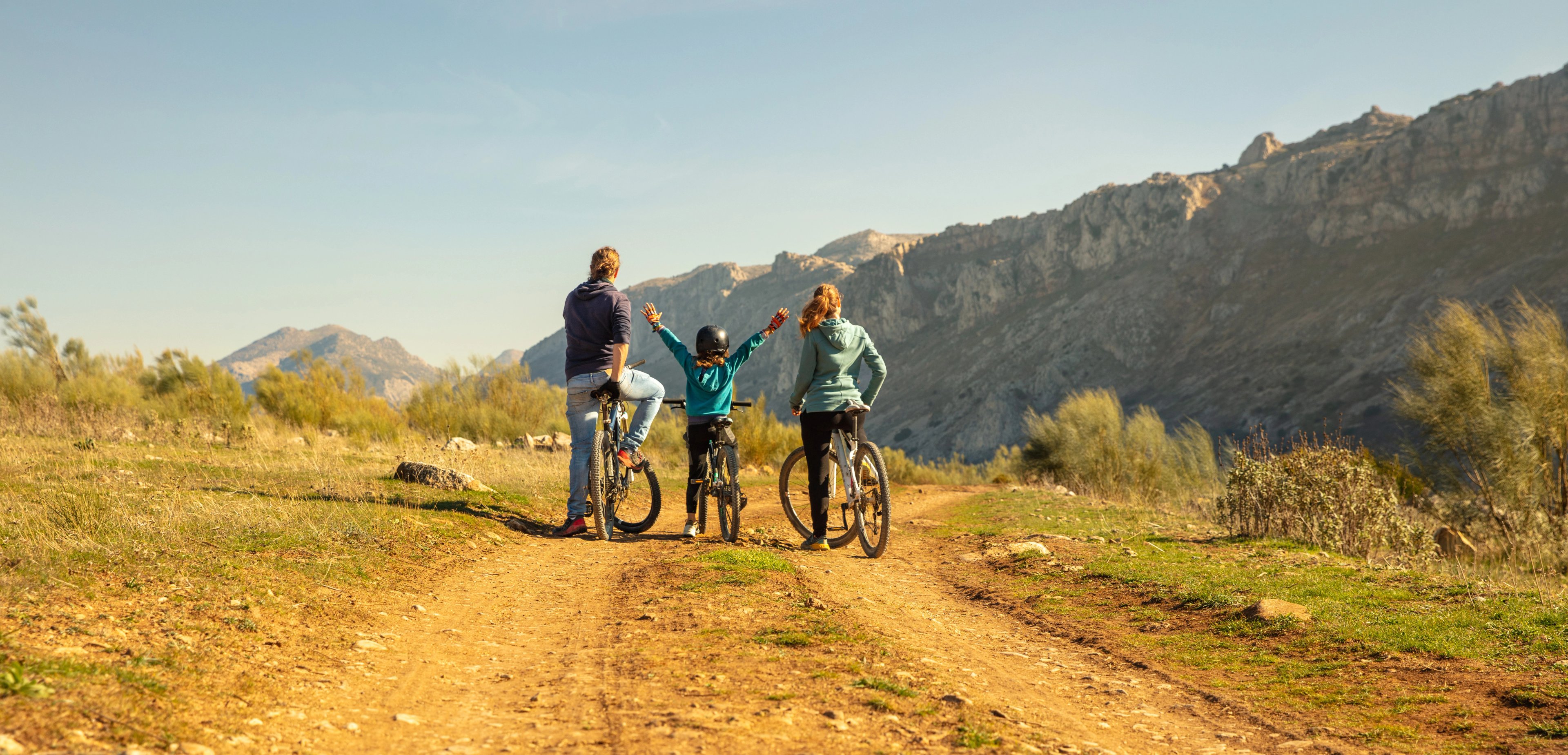
When to Go?
Andalusia’s Mediterranean climate makes cycling enjoyable from March to November, with warm temperatures, long daylight hours, and stable weather. Inland areas can become hot in peak summer, while spring and autumn offer the most comfortable conditions for multi-day touring.
Season Overview:
- Spring (March–June): Mild and bright, with 18–28 °C and clear skies. Almond trees flower in March, rural cafés reopen, and mornings stay cool. This is one of the most reliable periods for steady riding across the plateaus and valley corridors.
- Summer (July–August): Hot and dry, often 32–40 °C inland. Early starts are essential, but coastal provinces (Cádiz, Málaga) stay cooler with Atlantic breezes. Expect lively towns, long evenings, and strong light for photography.
- Autumn (September–October): Warm and calm, with 22–30 °C and minimal rainfall. Olive harvest begins across the Córdoba region, towns hold late-summer festivals, and rural roads stay quiet. Ideal for long-distance stages.
- Winter (November–February): Mild but variable, averaging 12–18 °C. Rain is occasional, and daylight is shorter, but cycling is still possible on valley and coastal routes. Higher sierras may experience colder nights.
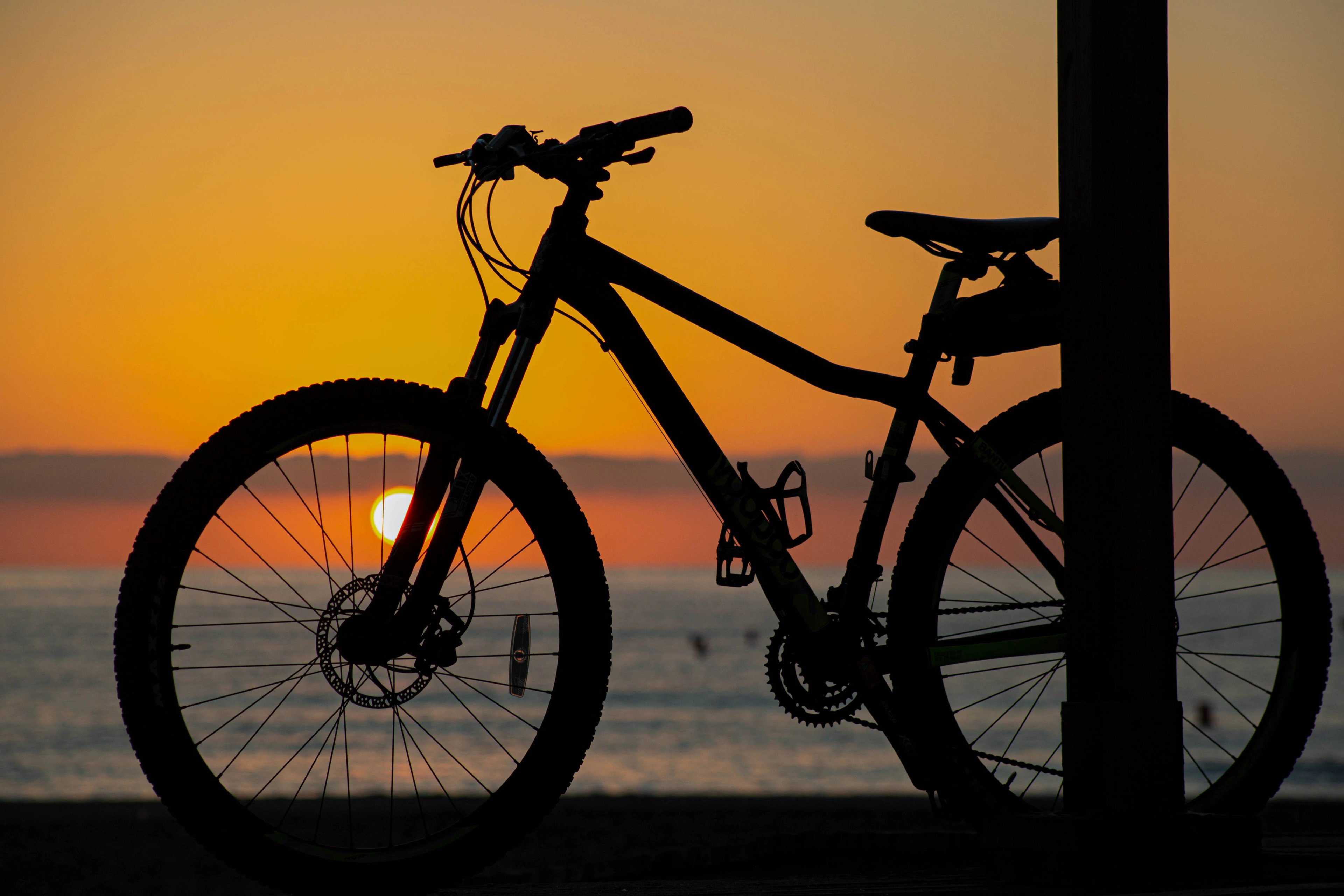
Tip: Inland temperatures rise quickly after midday from late spring onward, so most riders prefer early departures to enjoy cooler conditions and quieter roads.
For a broader overview of Spanish weather patterns across regions and seasons, see our monthly Spanish weather guide for cyclists.
Most Popular Cycling Routes
Andalusia’s varied terrain creates a natural set of cycling corridors — from converted railway greenways to rolling plateau routes and broad river valleys linking historic towns.
These key routes capture the region’s most characteristic riding styles and landscapes. Explore our full Andalusian tour offering to get a better understanding of the variety that is waiting for you in Andalusia.
1. Via Verde de la Subbética (Lucena – Zuheros – Luque)

A converted railway greenway through the Subbética Natural Park (approx. 65 km). Limestone cliffs, viaducts, and old station houses frame one of Andalusia’s easiest, most traffic-free rides.
Quick facts:
- Distance: ~65 km
- Highest point: ~650 m
- Difficulty: Easy
- Terrain: Smooth gravel/tarmac mix; gentle gradients below 2%
- Best for: Relaxed days, families, warm-up stages
Experience on:
2. Antequera to Córdoba (via Lucena and Baena)

A central-plateau route (approx. 110 km) linking olive-country towns with broad, open farmland. Expect quiet ridge roads, hilltop watchtowers, and a smooth final approach into Córdoba.
Quick facts:
- Distance: ~110 km
- Highest point: ~780 m
- Difficulty: Moderate
- Terrain: Rolling farmland, steady climbs, long plateau sections
- Best for: Scenic mid-week stages with cultural stops
3. Córdoba to Seville (via Palma del Río and Carmona)
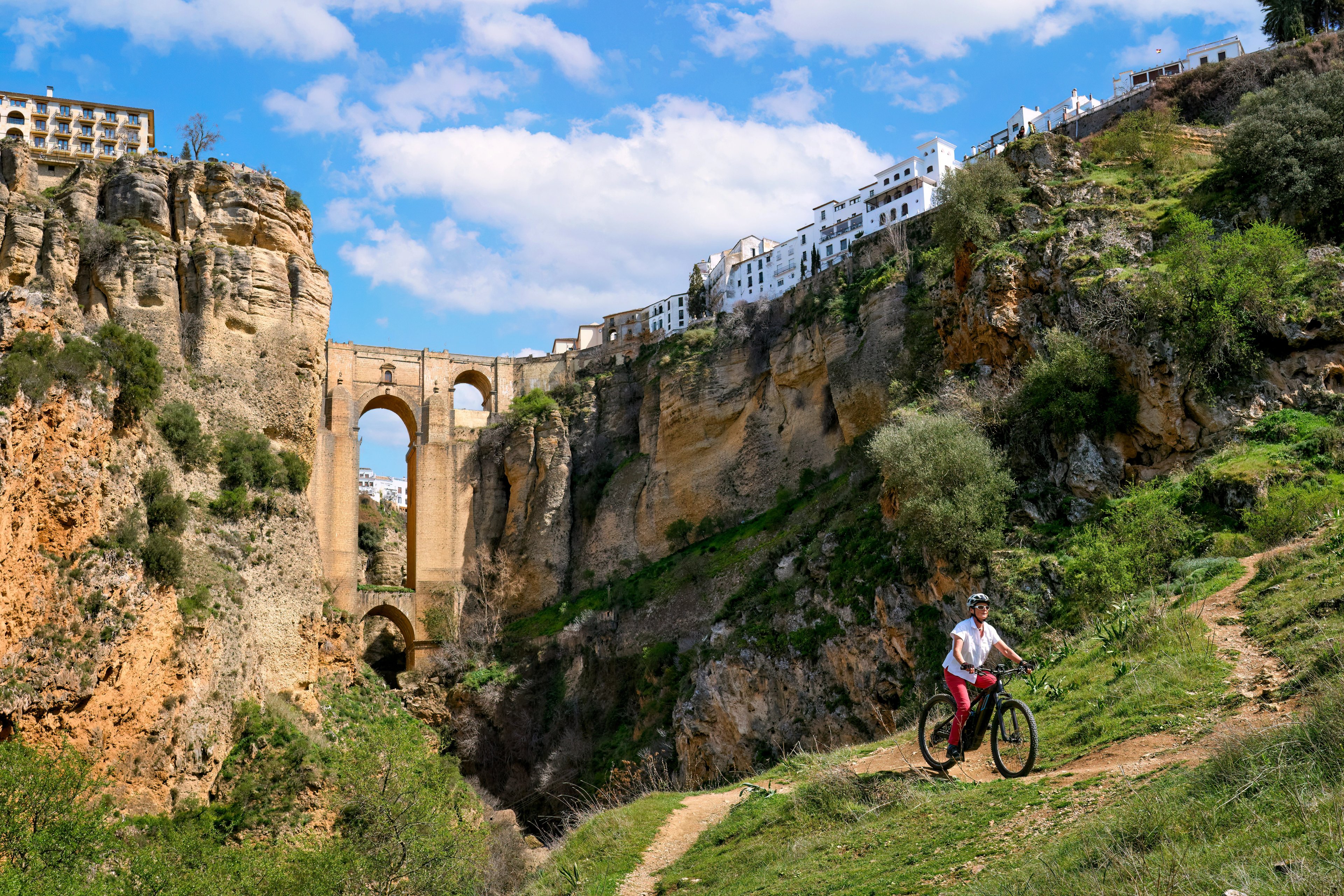
A largely flat corridor following the Guadalquivir valley (approx. 140 km). Riverside tracks, agricultural plains, and fortified towns define the route, with a final short climb into Carmona before descending to Seville.
Quick facts:
- Distance: ~140 km
- Highest point: ~250 m (Carmona ridge)
- Difficulty: Easy–Moderate
- Terrain: Flat valley paths, short ascents, mixed surfaces
- Best for: Fast, smooth riding and big-city finish days
4. Cádiz and the Costa de la Luz Corridor
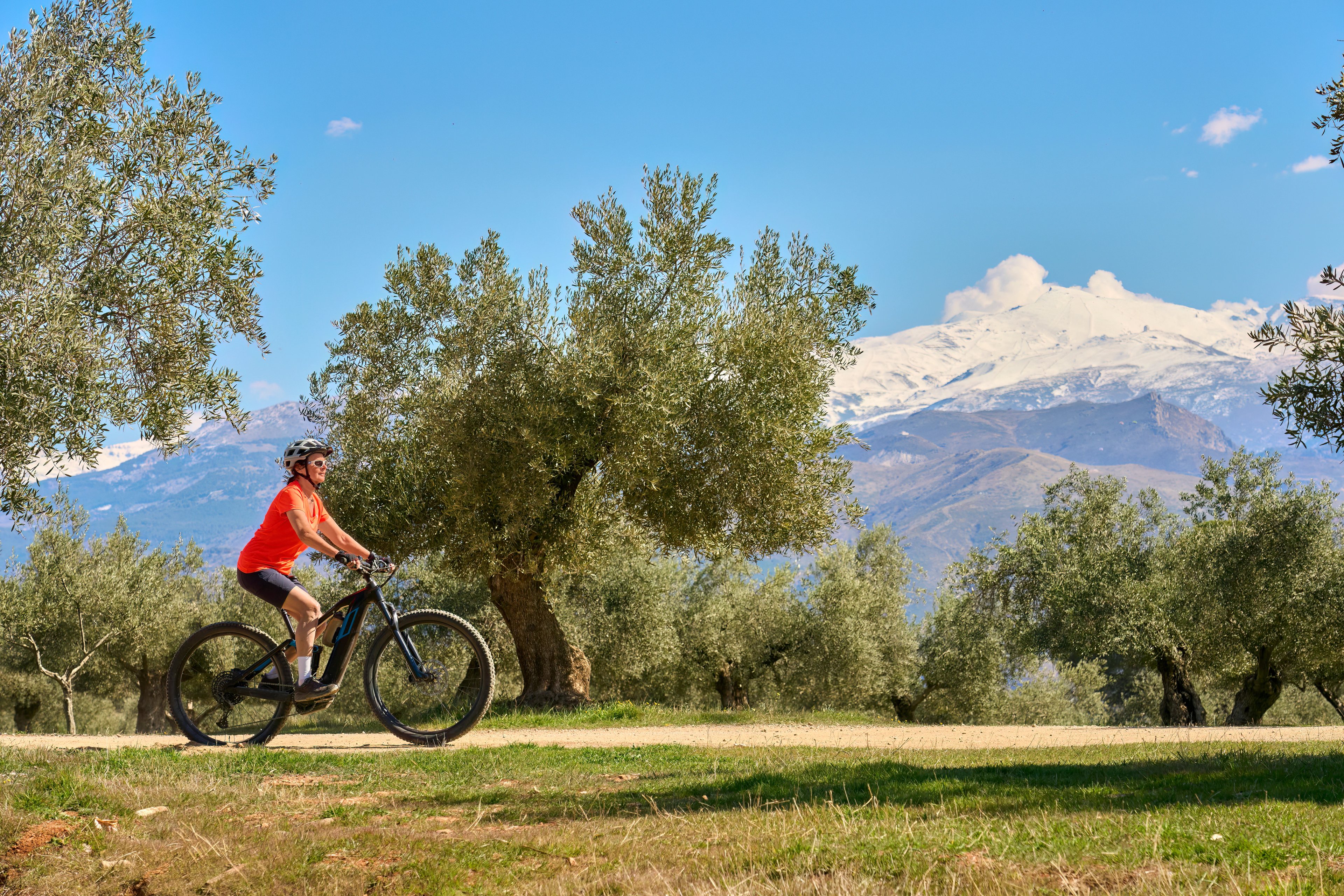
Running between Cádiz, Sanlúcar, and Vejer (variable 60–120 km), this route is shaped by Atlantic breezes, marshlands, and sherry-producing towns. Expect coastal fortifications, dunes, and white villages perched above the sea.
Quick facts:
- Distance: 60–120 km
- Highest point: ~200–250 m (Vejer area)
- Difficulty: Easy–Moderate
- Terrain: Mostly flat with short, steep climbs to hilltop towns
- Best for: Coastal scenery, maritime landscapes, steady spins
See this route on:
5. Sierra Nevada & Alpujarra Extension
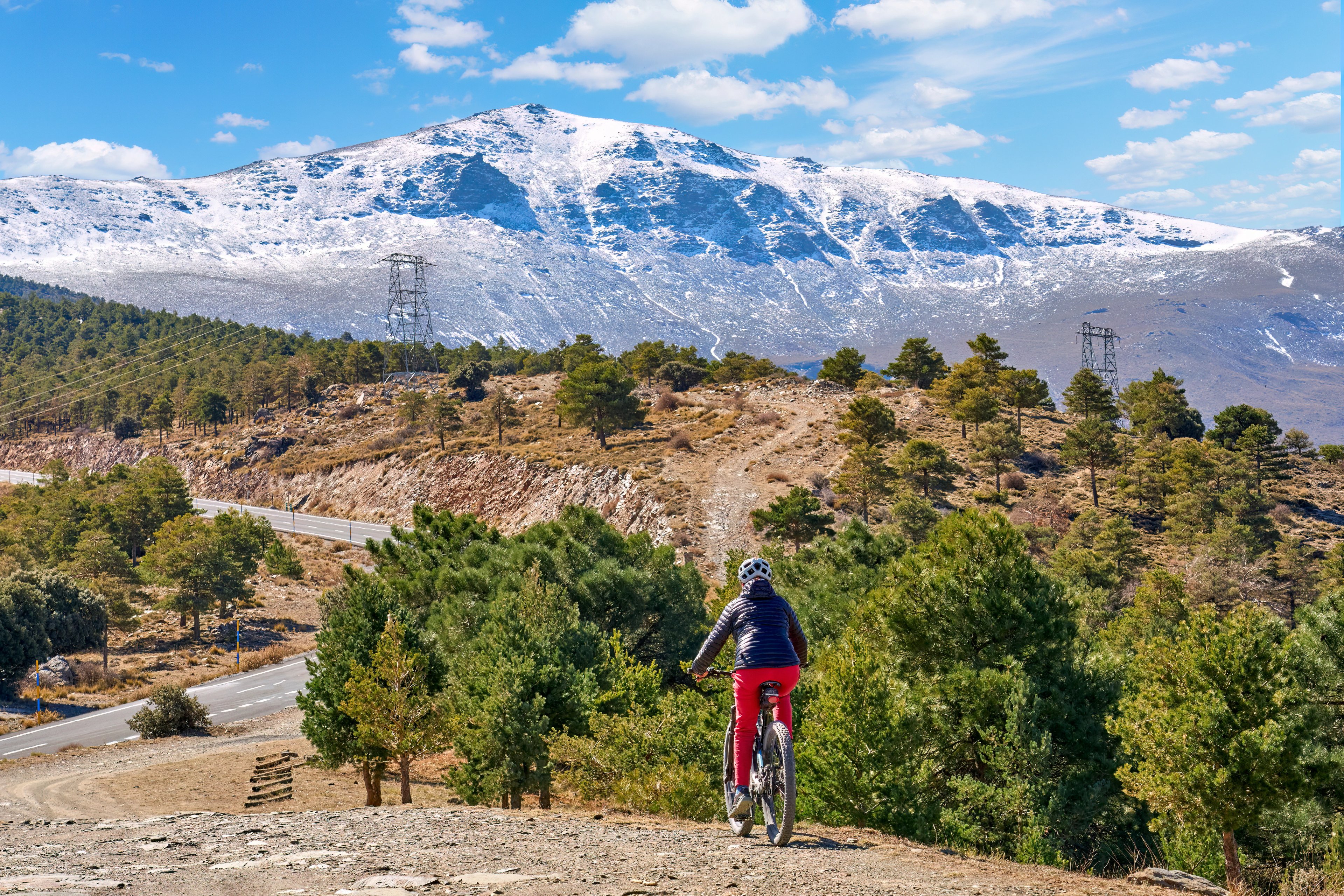
A demanding mountain option (50–90 km per stage) climbing into the foothills of the Sierra Nevada. The Alpujarras offer terraced hillsides, deep valleys, and white villages linked by narrow ridgelines.
Quick facts:
- Distance: 50–90 km per stage
- Highest point: 1,400–1,800 m (varies by route)
- Difficulty: Moderate–Hard
- Terrain: Steep, technical climbs; cooler high-altitude conditions
- Best for: Experienced riders wanting long ascents and dramatic scenery
Ride this route on our tour:
Suggested Itinerary: Cycling Holidays Andalusia
This 7-day route follows a scenic corridor from Antequera to Seville, linking historic towns, fertile valleys, and quiet olive-growing plateaus. Daily distances are moderate, gradients steady, and cultural landmarks appear in quick succession — making it an ideal introduction to southern Spain’s landscapes and traditions.
Day 1: Arrival in Antequera

Settle into Antequera, a natural gateway between Andalusia’s provinces. The town’s alcazaba, baroque churches, and nearby limestone formations of El Torcal set the scene for the days ahead.
Day 2: Antequera → Lucena
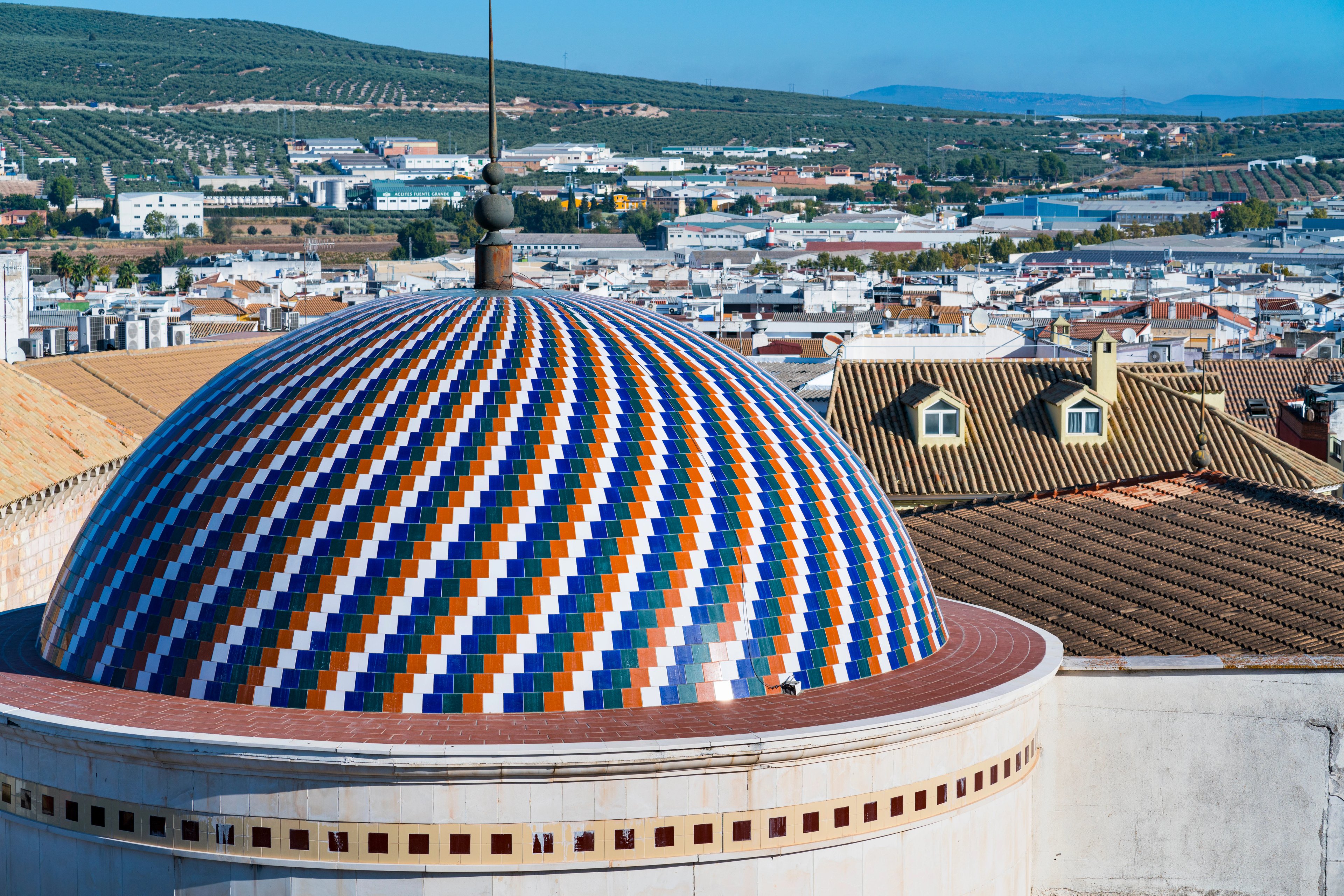
The route begins on former railway corridors and rural lanes with open views across the central plateau. Lucena sits in one of Spain’s major olive-oil regions, with traditional mills and a lively historic center.
Distance: ~69 km
Elevation: ~810 m
Surface: Paved rural roads with steady climbs; short sections on former railway paths
Day 3: Lucena → Baena

Cycling through small agricultural towns, the landscape becomes more intimate — a mix of quiet ridges, orchards, and village squares. Places like Cabra, Doña Mencía, and Zuheros offer glimpses of traditional rural life.
Distance: ~43 km
Elevation: ~515 m
Surface: Paved secondary roads through agricultural areas; occasional rough patches near village edges
Day 4: Baena → Córdoba
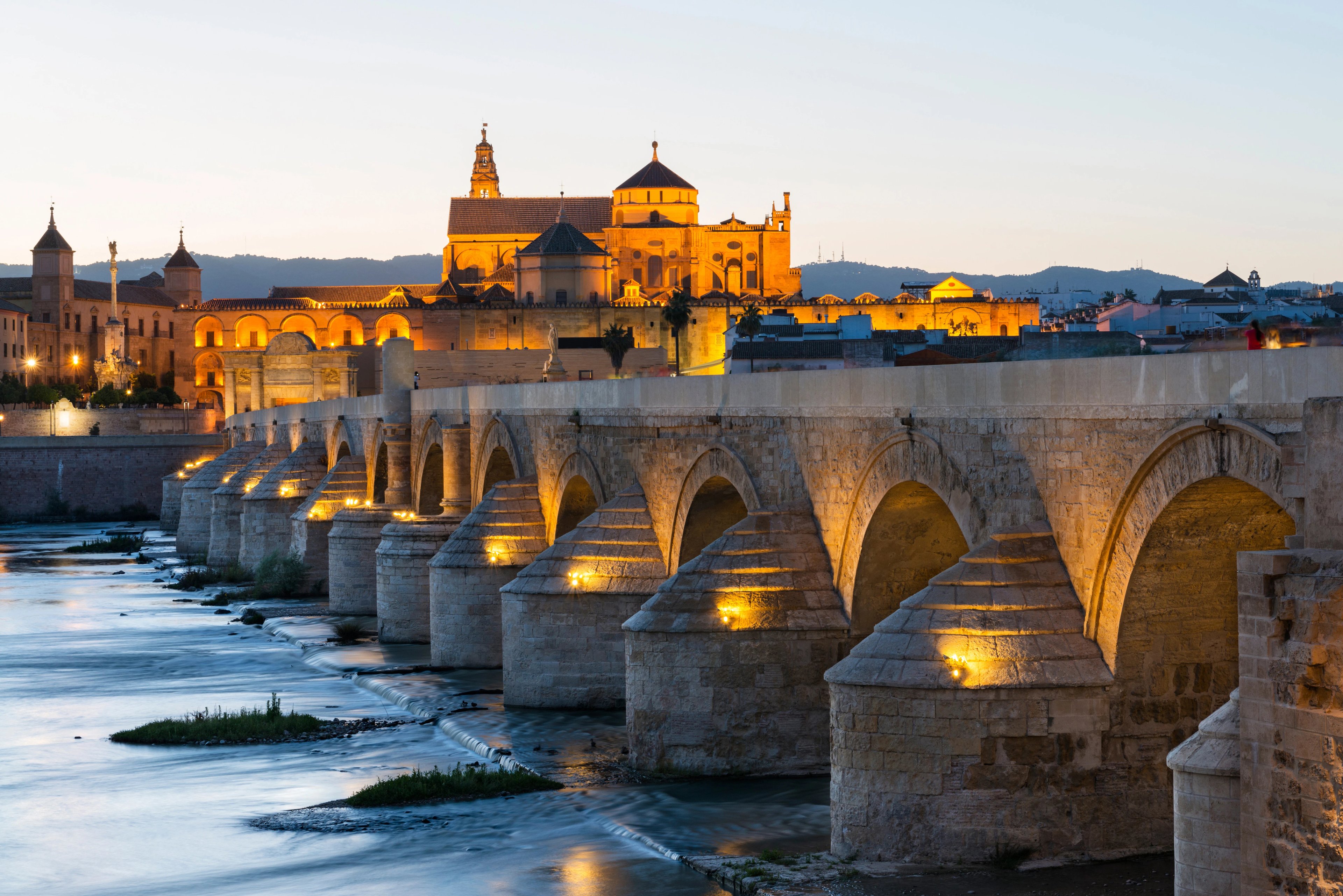
Rolling hills lead toward the wide Guadalquivir valley. Approaching Córdoba, the terrain softens and views open toward the city’s historic skyline, where the Mezquita and Roman bridge mark the entrance to one of Spain’s great cultural centers.
Distance: ~64 km
Elevation: ~690 m
Surface: Mostly paved rural roads; light traffic near Córdoba’s outskirts
Day 5: Córdoba → Palma del Río
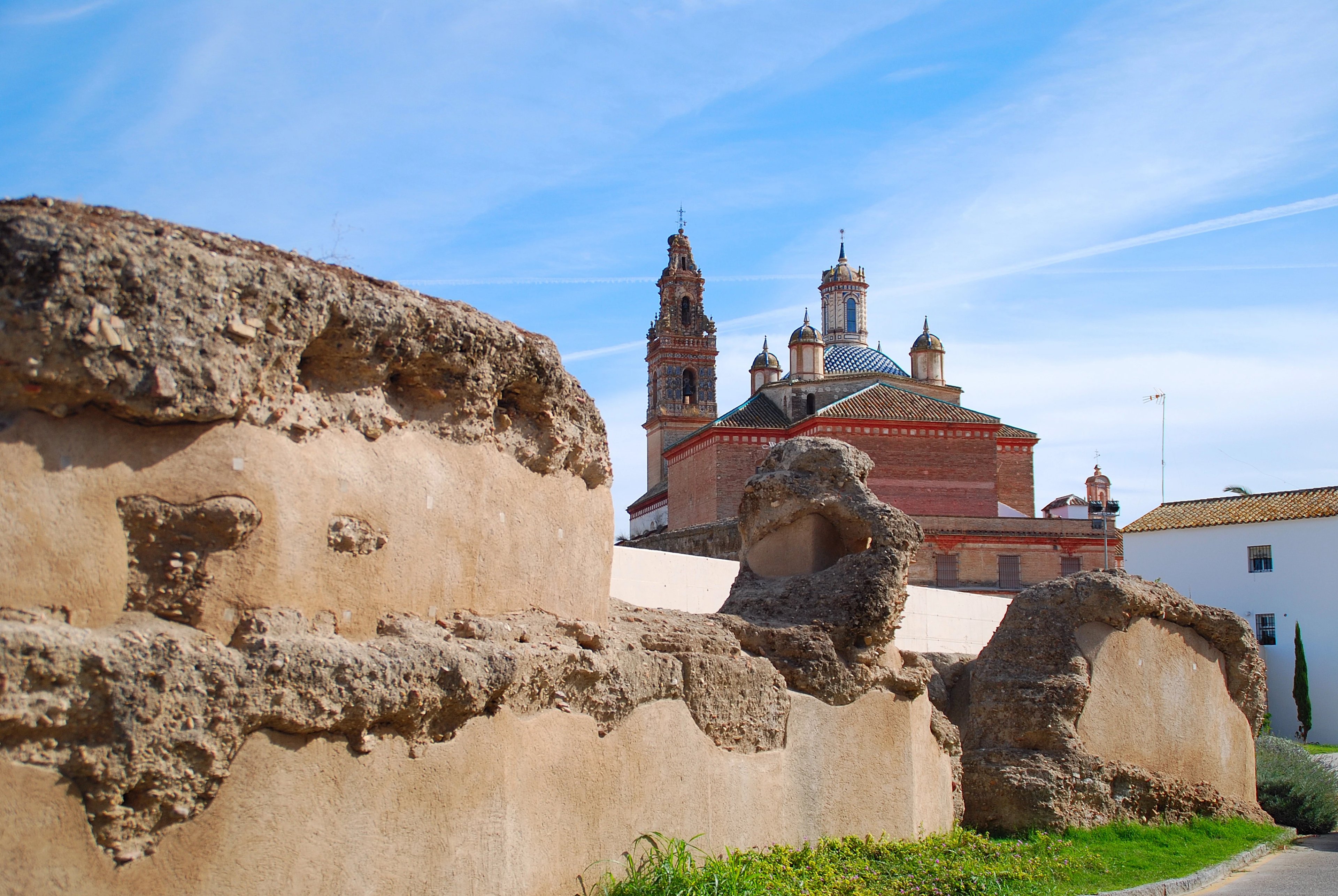
Crossing gentle farmland, the route passes through Écija — long known for its equestrian tradition. The final stretch continues through rural estates toward Palma del Río, a town shaped by monasteries, citrus groves, and river life.
Distance: ~57 km
Elevation: ~275 m
Surface: Smooth paved roads across agricultural plains; low-traffic connectors
Day 6: Palma del Río → Carmona
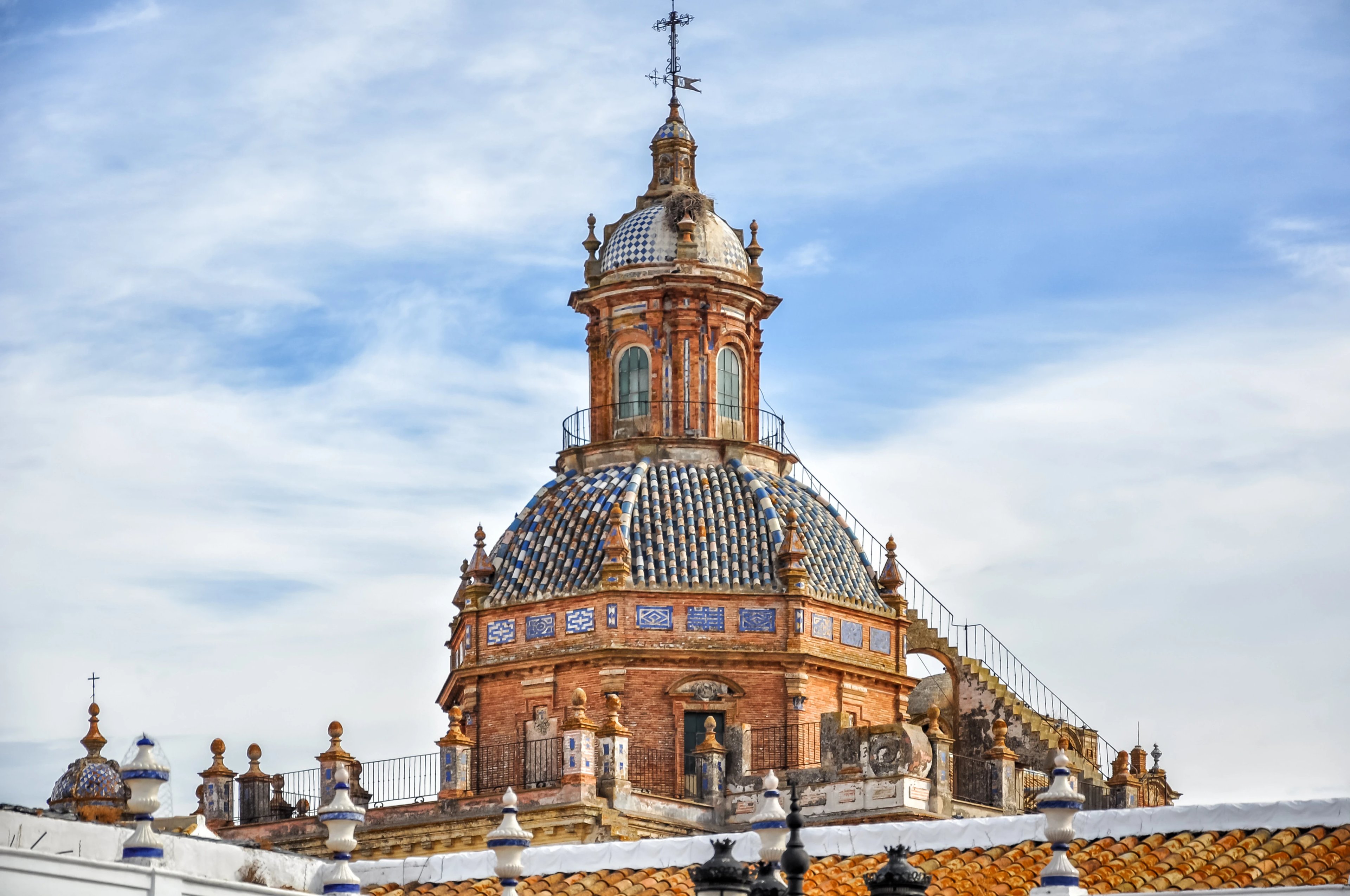
A calm day of countryside riding with broad valley views. Carmona, perched on a ridge, welcomes riders with Renaissance palaces, arcaded squares, and impressive fortifications that have stood for centuries.
Distance: ~55 km
Elevation: ~365 m
Surface: Paved farmland routes with gentle gradients; well-maintained approach into Carmona
Day 7: Carmona → Seville
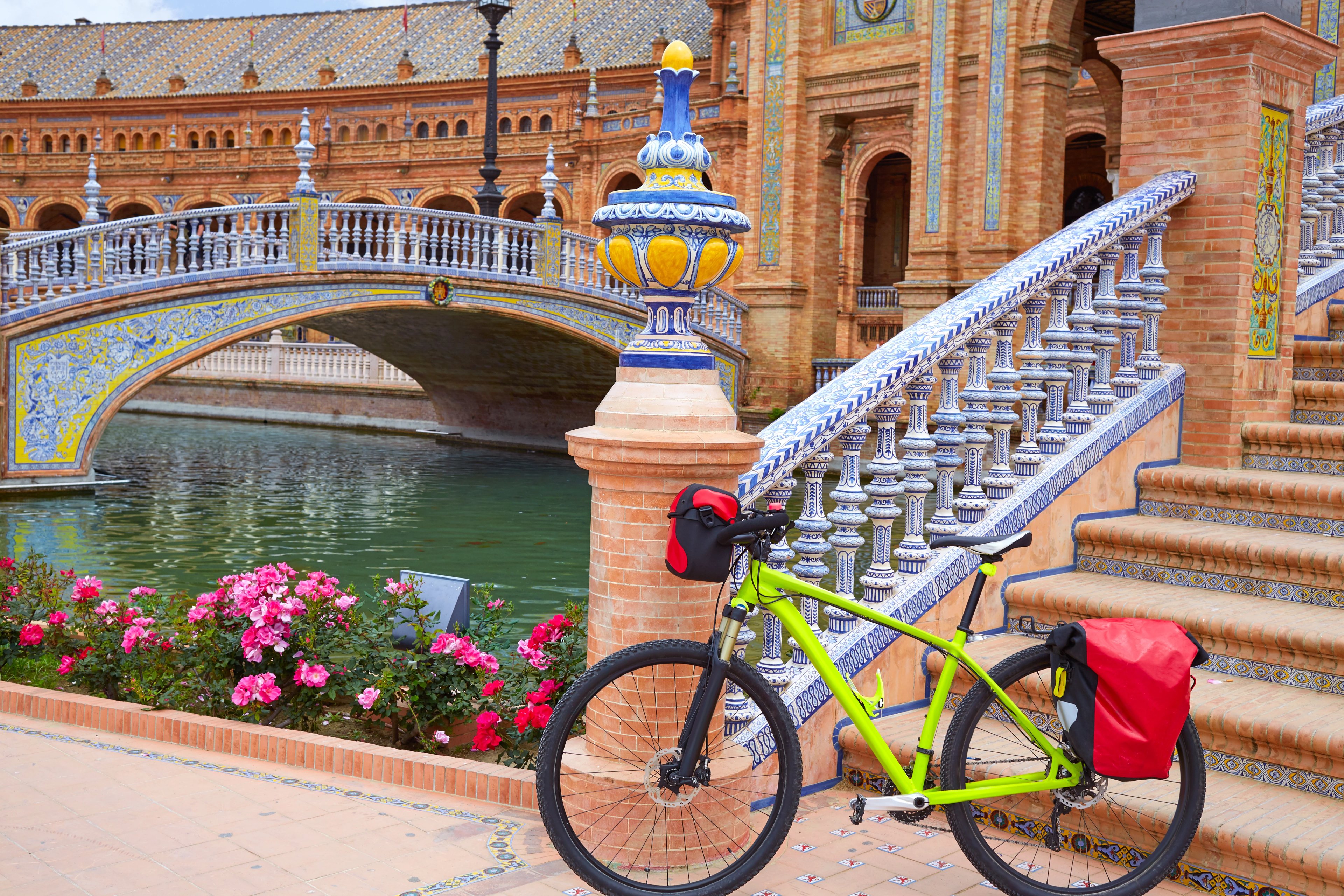
Crossing the Alcores plateau, the route approaches Seville through quiet agricultural landscapes. Passing Alcalá de Guadaíra — long associated with mills and breadmaking — the final kilometers enter Seville’s extensive cycle network and historic center.
Distance: ~45 km
Elevation: ~255 m
Surface: Paved plateau roads; transition to Seville’s urban cycle lanes in final kilometers
Day 8: Departure from Seville
Your journey concludes in Seville, a city defined by grand plazas, tiled courtyards, and a vibrant cultural rhythm. Trains and flights from here connect easily with Spain and the rest of Europe.
See the best of it here:
Cultural & Natural Highlights
Andalusia’s cycling routes pass through one of Europe’s richest cultural corridors, where Roman roads, Moorish architecture, Renaissance churches, and agricultural traditions coexist within short riding distances. The landscape is equally varied — from fertile river valleys to limestone ridges and quiet plains shaped by centuries of olive cultivation.
Highlights along the region include:
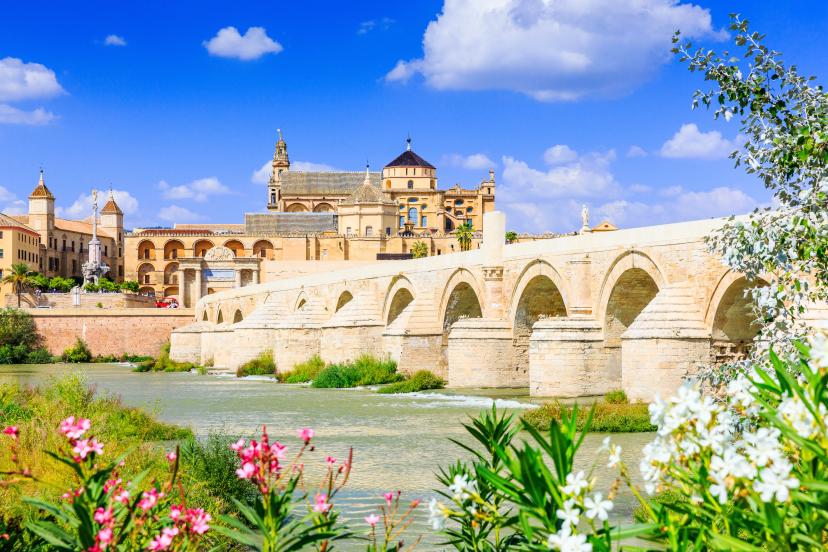
Córdoba
Once the capital of Al-Andalus, Córdoba blends Roman foundations with Moorish architecture, creating one of southern Spain’s most distinctive historic centers. Its compact old town centers on the Mezquita’s arcaded courtyard, narrow lanes, and riverfront mills along the Guadalquivir. For cyclists, the city serves as a natural pause point between Andalusia’s plains and surrounding sierras, with well-marked routes leading straight from the historic core into open countryside.

Carmona
Perched on a hill overlooking the Guadalquivir valley, Carmona is a historic town brimming with Roman, Moorish, and Christian heritage. Its old town features cobbled streets, ancient walls, and monumental gates like the Puerta de Sevilla, while the Alcázar de la Puerta de Marchena and Necropolis highlight its rich past. From panoramic viewpoints to traditional Andalusian architecture, Carmona offers visitors a journey through centuries of culture and breathtaking scenery.
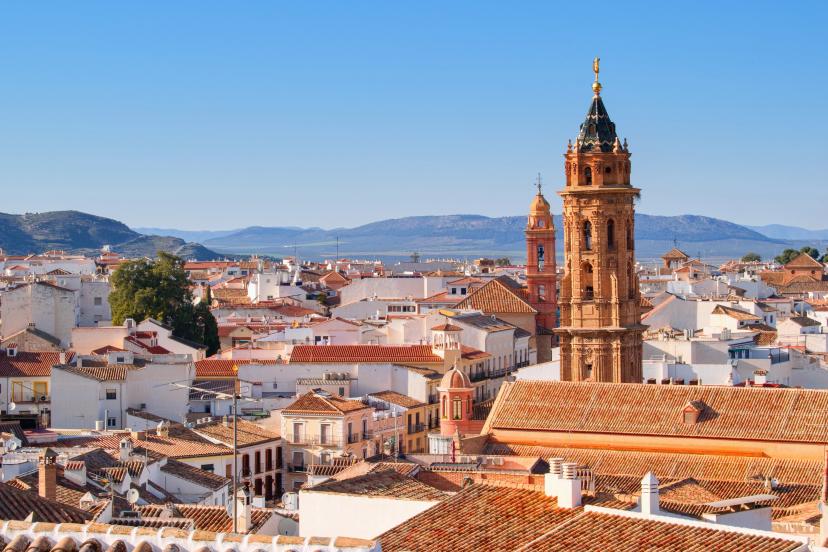
Antequera
Located at the crossroads of Andalusia’s major plains, Antequera is defined by its hilltop Alcazaba, baroque churches, and the nearby UNESCO-listed dolmens. The surrounding terrain shifts quickly from flat agricultural basins to rolling limestone hills, giving riders a varied landscape within a short radius. It also acts as a gateway to El Torcal, whose karst formations form one of the region’s most unique natural backdrops.
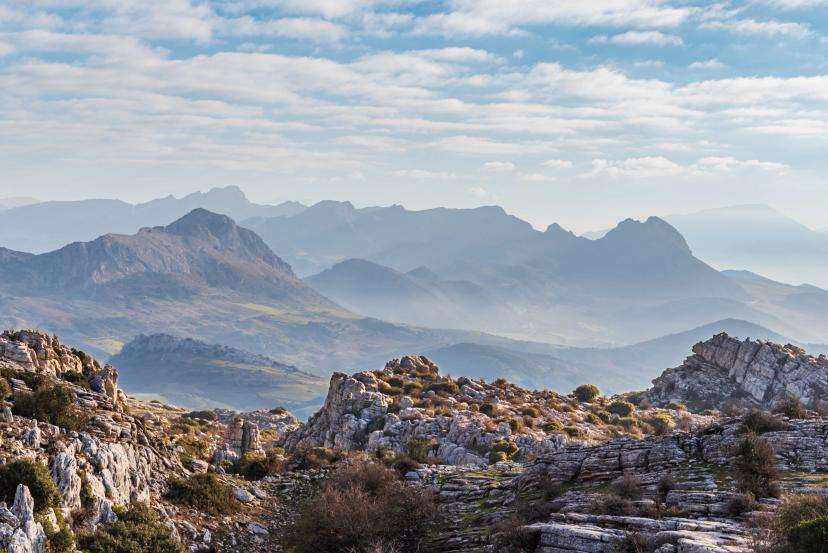
Subbética Natural Park
This protected area in the heart of Andalusia centers on rugged limestone massifs, deep valleys, and quiet white-village trails. Elevations rise quickly, offering steady climbs, sweeping viewpoints, and shaded cork-oak sections that contrast with the surrounding olive-farm plains. The park’s well-maintained paths and low-traffic roads provide a scenic transition between Córdoba, Jaén, and Granada provinces.

Guadalquivir Valley
Stretching from the Sierra de Cazorla to the Atlantic coast, the Guadalquivir Valley forms Andalusia’s principal agricultural and historic corridor. Its broad plains and gentle gradients create naturally easier cycling conditions, linking cities like Córdoba and Seville through open farmland and river landscapes. Seasonal light, rice fields, and historic irrigation canals add a distinctive character that contrasts with the region’s surrounding sierras.

Seville
Seville, the vibrant capital of Andalusia, is a city where history and culture intertwine seamlessly. The Seville Cathedral, the largest Gothic cathedral in the world, houses the tomb of Christopher Columbus. Other highlights include the stunning Plaza de España, with its sweeping semi-circular façade and intricate tilework, and the towering Giralda, a minaret-turned-bell tower offering panoramic city views.
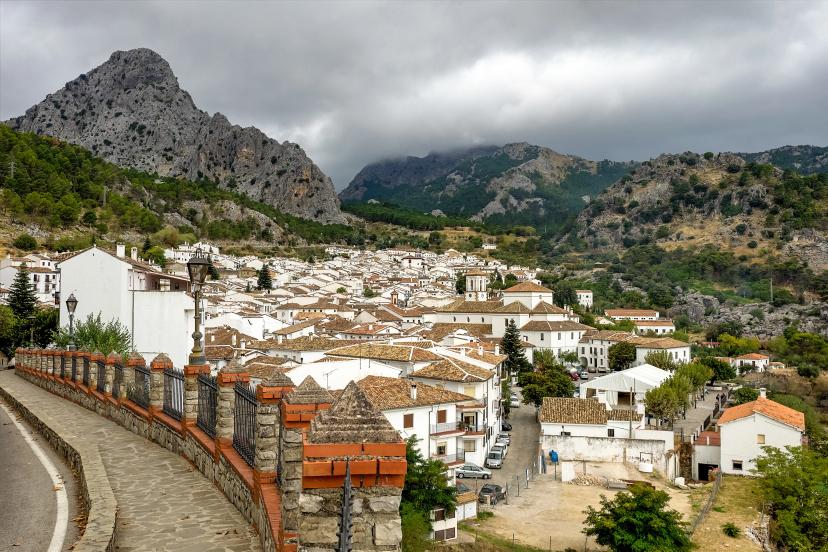
White Villages Route
This classic route threads through Andalusia’s pueblos blancos, a chain of hilltop settlements marked by whitewashed houses, narrow lanes, and elevated viewpoints over olive groves and limestone ranges. Terrain shifts from rolling foothills to steeper climbs near the Sierra de Grazalema, giving the route a mix of steady mileage and short, punchy ascents. The villages provide natural pause points with small plazas, local cafés, and panoramic terraces that break the ride into well-spaced segments.
For more inspiration beyond Andalusia, explore our full list of must-see places in Spain, covering national parks, UNESCO sites, and top cultural landmarks across the country.
Food & Regional Specialities
Andalusia’s cuisine is rooted in simple ingredients, olive-oil traditions, and a long blend of Mediterranean, Roman, and Moorish influences. Cycling routes pass directly through the region’s agricultural heartlands, so meals are seasonal, locally sourced, and ideal for refuelling after a day on the bike. Each province has its own specialties, with towns along the route offering reliable cafés, tapas bars, and shaded terraces for breaks.
What to Try Along the Way

Salmorejo
A signature dish of Córdoba, Salmorejo is a thick cold purée of tomatoes, bread, olive oil, and garlic, traditionally garnished with chopped egg and cured ham. Compared with gazpacho, it’s creamier and more substantial, making it a popular mid-day meal in hot weather. Its simplicity highlights the region’s reliance on ripe tomatoes and high-quality olive oil.

Ajoblanco
This almond-based cold soup originates in Málaga and Granada provinces and predates the arrival of tomatoes in Spain. Blended from bread, garlic, and local almonds, it has a mild, refreshing flavor often paired with grapes or melon. Its light texture and chilled serving make it a practical warm-weather dish across the inland valleys.

Flamenquín
A Córdoba classic, Flamenquín consists of ham rolled inside pork loin, coated in breadcrumbs, and fried until crisp. Portions vary by town, with some versions shaped into long spirals and others served as smaller cuts. Its combination of cured ham and lightly seasoned pork reflects the traditional tavern cooking of the area.
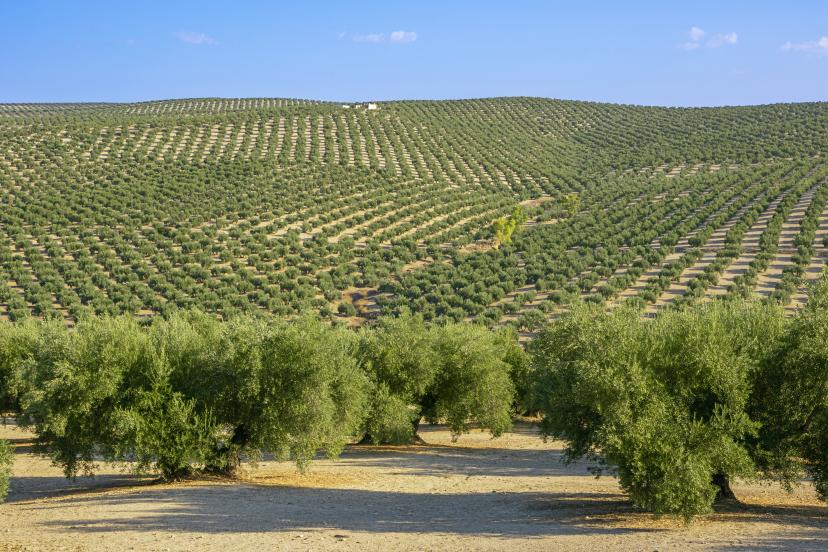
Andalusian Olive Oil
The towns of Baena and Lucena sit within some of Andalusia’s most productive olive-growing zones, known for early-harvest extra-virgin oils made primarily from Picudo and Hojiblanca varieties. Tastings often compare fruity, green, and peppery profiles, giving a clear sense of how soil and altitude shape local oils. These sessions provide a straightforward introduction to the region’s long-established olive cooperatives and mills.

Pestiños
Pestiños are small, honey-glazed pastries found across Andalusia, especially during festivals and winter months. The dough is lightly flavored with sesame or anise, then fried and coated in syrup, resulting in a firm exterior and subtle sweetness. Their long regional history links them to Moorish culinary traditions still visible in local baking.
Looking to explore more regional flavors across Spain? See our guide for dishes, drinks, and culinary stops that pair naturally with cycling routes nationwide.
Cycling Conditions & Infrastructure
Andalusia’s cycling network combines quiet rural roads, Via Verde greenways, and well-connected city cycle lanes. While not as uniformly signposted as Central Europe, the region offers reliable surfaces, clear navigation, and consistent access to towns for services. Terrain varies from flat river corridors to rolling plateaus and occasional ridge climbs.

Route Layout
- A mix of secondary rural roads, old railway lines, and valley corridors connecting major towns.
- Vías Verdes (Subbética, Aceite, Campiña) offer long, low-gradient, traffic-free stretches.
- Most routes run through agricultural landscapes, with regular intersections but low traffic.
Terrain & Gradients
- Rural roads: Mostly smooth asphalt with short, steady climbs near village edges.
- Via Verdes: Compact gravel or paved sections; gradients rarely exceed 2–3%.
- Sierras: Optional steeper ascents for stronger riders, especially near Subbética or the Sierra Morena.
Signage
- Via Verde routes: Clearly marked with green signage, kilometer markers, and old station posts.
- Rural connectors: Basic local signage; GPX assistance recommended for consistency.
- City entries: Good cycle-lane coverage in Córdoba, Seville, Málaga, and Cádiz.
Bike Support
- Bike shops & repairs: Concentrated in larger cities (Córdoba, Málaga, Seville).
- E-bike charging: Available in most hotels; rural cafés occasionally allow charging during breaks.
- Rentals: Strong availability in Seville, Málaga, Córdoba; limited in smaller towns.
Rail & Transport Links
- RENFE regional trains connect most provincial cities and allow bikes on many services (small fee or designated carriage).
- High-speed trains require bike bags; useful for fast access to Málaga, Córdoba, or Seville before starting a tour.
- Local buses vary in bike acceptance; advance confirmation needed outside major hubs.
Safety & Road Culture
- Rural roads have light traffic, especially outside rush hours.
- Drivers generally give wide passing distance; cycling tourism is well recognized.
- Shade is limited — early departures advised from late spring to early autumn.
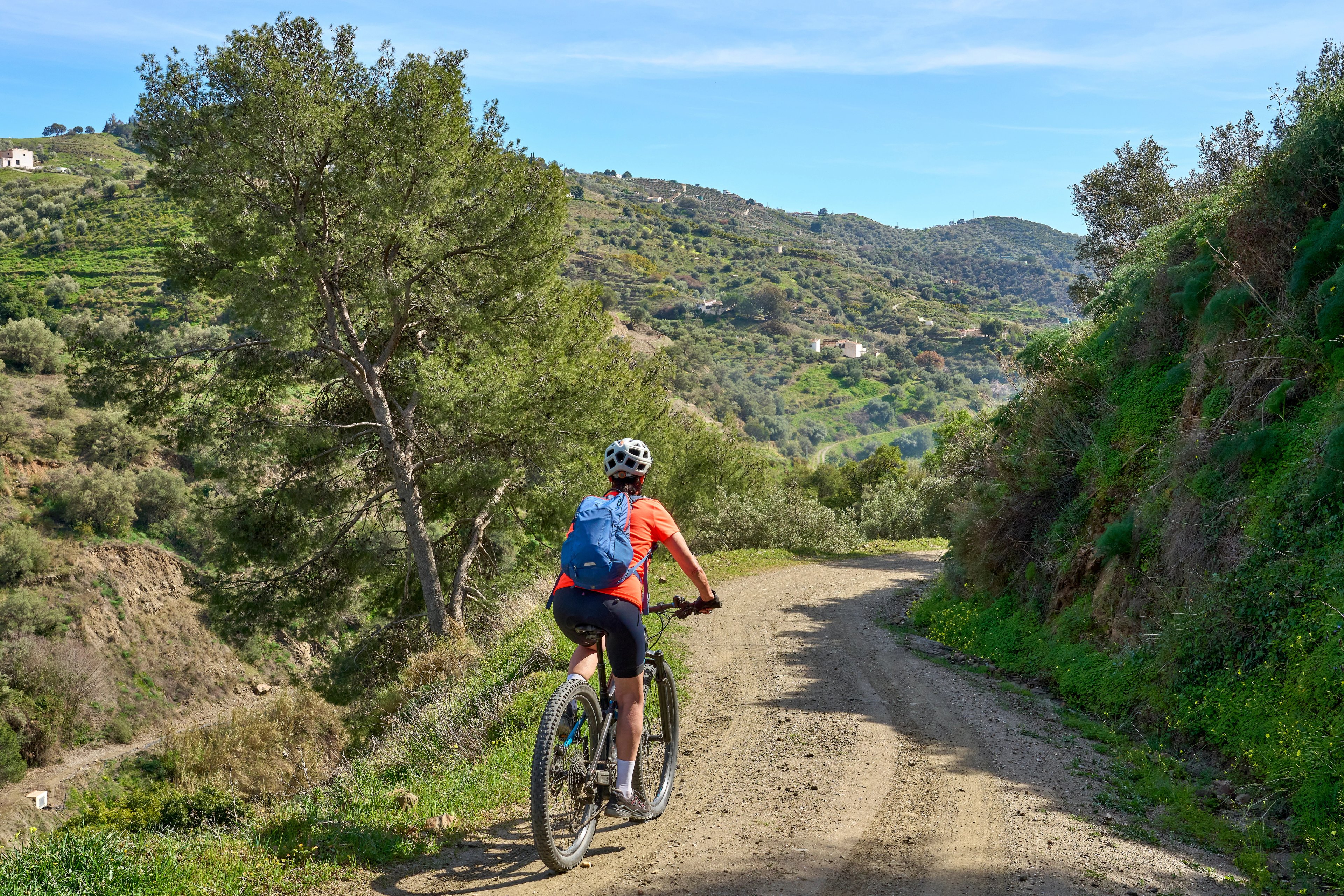
Navigation Tools
- GPX tracks are needed for all rural stretches. We provide them for self-guided tours.
- Towns and villages appear frequently, making staged planning straightforward.
What to Pack
Packing for an Andalusia cycling trip is straightforward: conditions are warm, towns are frequent, and most days follow steady rural routes. The inland climate can shift from cool mornings to strong afternoon heat, especially from late spring to early autumn, so light, breathable layers work best.
Essentials
- Cycling gear: Padded shorts, breathable jerseys, a lightweight windbreaker, and a sun-protective layer for warmer afternoons.
- Footwear: Comfortable cycling shoes or trainers suitable for pedaling and short walks through historic centers.
- Helmet: Recommended for all riders.
- Day bag or panniers: Useful for water, snacks, and personal items on longer countryside stretches.
- Powerbank: To keep GPX files and navigation apps running throughout the day.
- Reusable water bottle and electrolytes: Inland stretches can be dry with limited shade — hydration is key.
- Basic first aid kit: Bandages, sunscreen, pain relief, and electrolytes for hot-weather stages.
- Travel documents: Passport/ID, insurance, and hotel confirmations.

Optional Extras
- E-bike charger or spare battery (charging available at most hotels).
- Arm/leg warmers for cooler early mornings in March or November.
- Compact lock for quick café or sightseeing stops.
- Light buff or bandana for sun protection on exposed plateau sections.
- Small towel or swimsuit if ending your trip with a coastal stop or hotel pool.
For more detailed guidance across Spain’s regions and seasons, see our ultimate cycling guide for the entire country.
Getting to the Start — Antequera
Andalusia is easy to reach from within Spain and across Europe. The region is well connected by air, high-speed rail, and intercity bus networks, making arrival and onward travel straightforward.
By Air
Three international airports serve as the main gateways into the region:
- Málaga Airport (AGP) – Andalusia’s largest hub with extensive European connections
- Seville Airport (SVQ) – Strong links to major Spanish and European cities
- Granada Airport (GRX) – Convenient for travelers arriving from Madrid, Barcelona, and selected European hubs
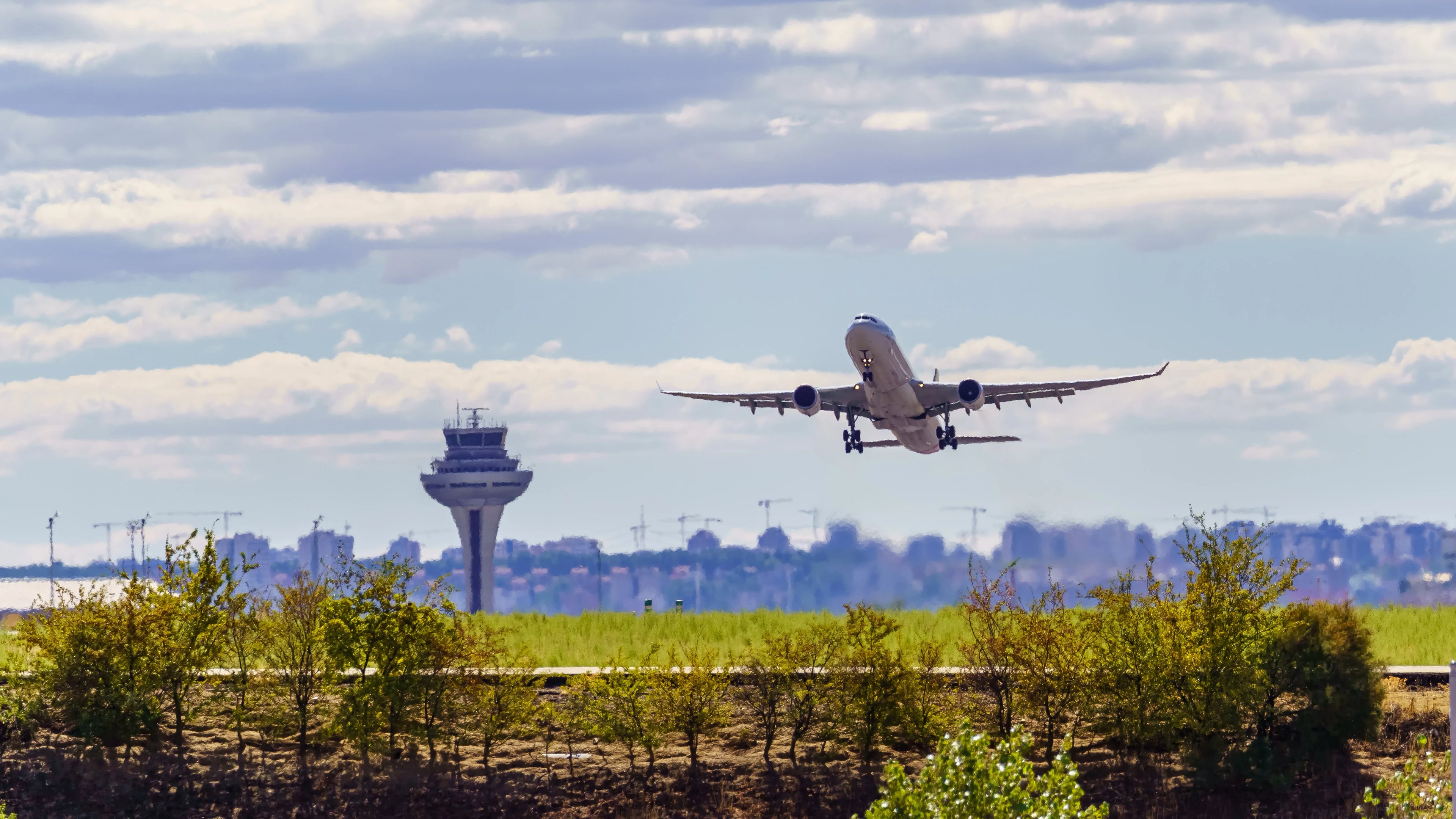
Smaller airports in Jerez and Almería also offer seasonal and regional routes.
Travelling Around the Region
If you are travelling by public transport, Andalusia is reliable and well connected thanks to its modern infrastructure.
Trains
High-speed and regional trains connect Andalusia with the rest of Spain and link major cities within the region.
- AVE and Alvia high-speed services operate between Málaga, Seville, Córdoba, Granada, Madrid, and Barcelona
- Local and regional lines serve smaller towns across the provinces
Official schedules and tickets: Renfe. Most long-distance services accept bicycles, sometimes requiring a bike bag or small fee.
Buses
Intercity buses provide extensive coverage, especially in areas not served by rail. Services link major cities with medium and small towns across all eight provinces. Main operators and schedules: ALSA. Regional companies operate additional routes within each province.
Returning from the Finish — Seville
Finishing your ride in Seville brings the journey to a memorable close. The city’s historic center, extensive cycle lanes, and excellent transport connections make onward travel simple and efficient.
By Air
The nearest airport is Seville Airport (SVQ), just 10 kilometers from the city center, with regular flights to major hubs including Madrid, Barcelona, Lisbon, London, Paris, Frankfurt, Amsterdam, and more.
Other airports commonly used after completing the route include:
- Málaga Airport (AGP): Around 2 hours by direct train; ideal for long-haul options and wider European connections.
- Jerez Airport (XRY): About 1.5 hours from Seville by train or bus; useful for southwestern Spain connections.
By Train
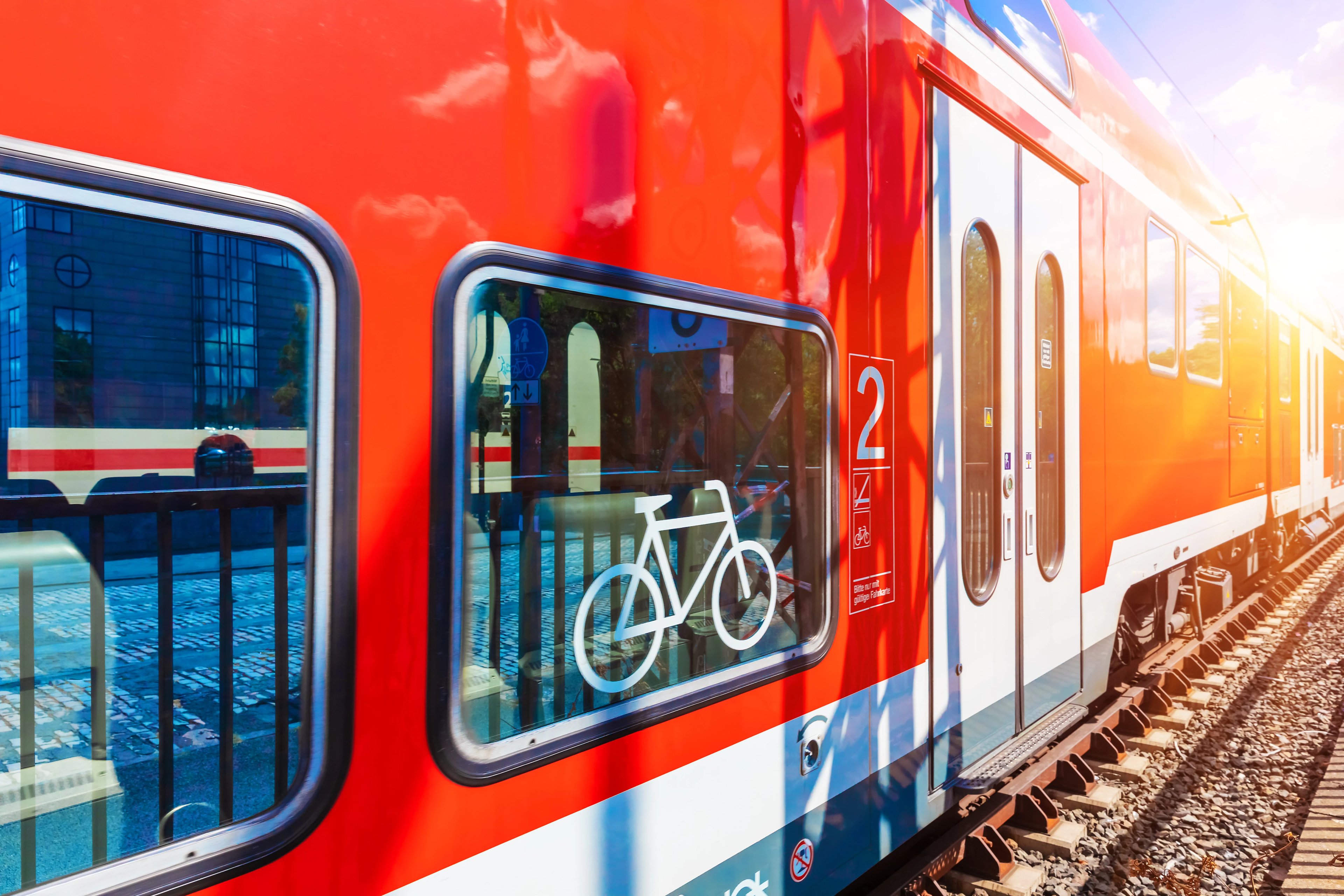
Seville’s main station, Santa Justa, is one of Spain’s central rail hubs:
- High-speed AVE links Seville with Madrid (2.5 hours) and Barcelona (5.5 hours).
- Regional trains connect directly with Córdoba, Cádiz, Málaga, and other Andalusian cities.
- Most services offer bike transport with prior reservation or a bike bag.
Private transfers and train tickets can be arranged directly through us, ensuring a smooth, stress-free start and finish to your Andalusian cycling holiday.
Self-Guided Cycling in Andalusia
Planning a self-guided trip in Andalusia is rewarding: compact distances, good weather, and a dense network of towns make the region ideal for an independent holiday. What helps most is having the right support in place from the start.
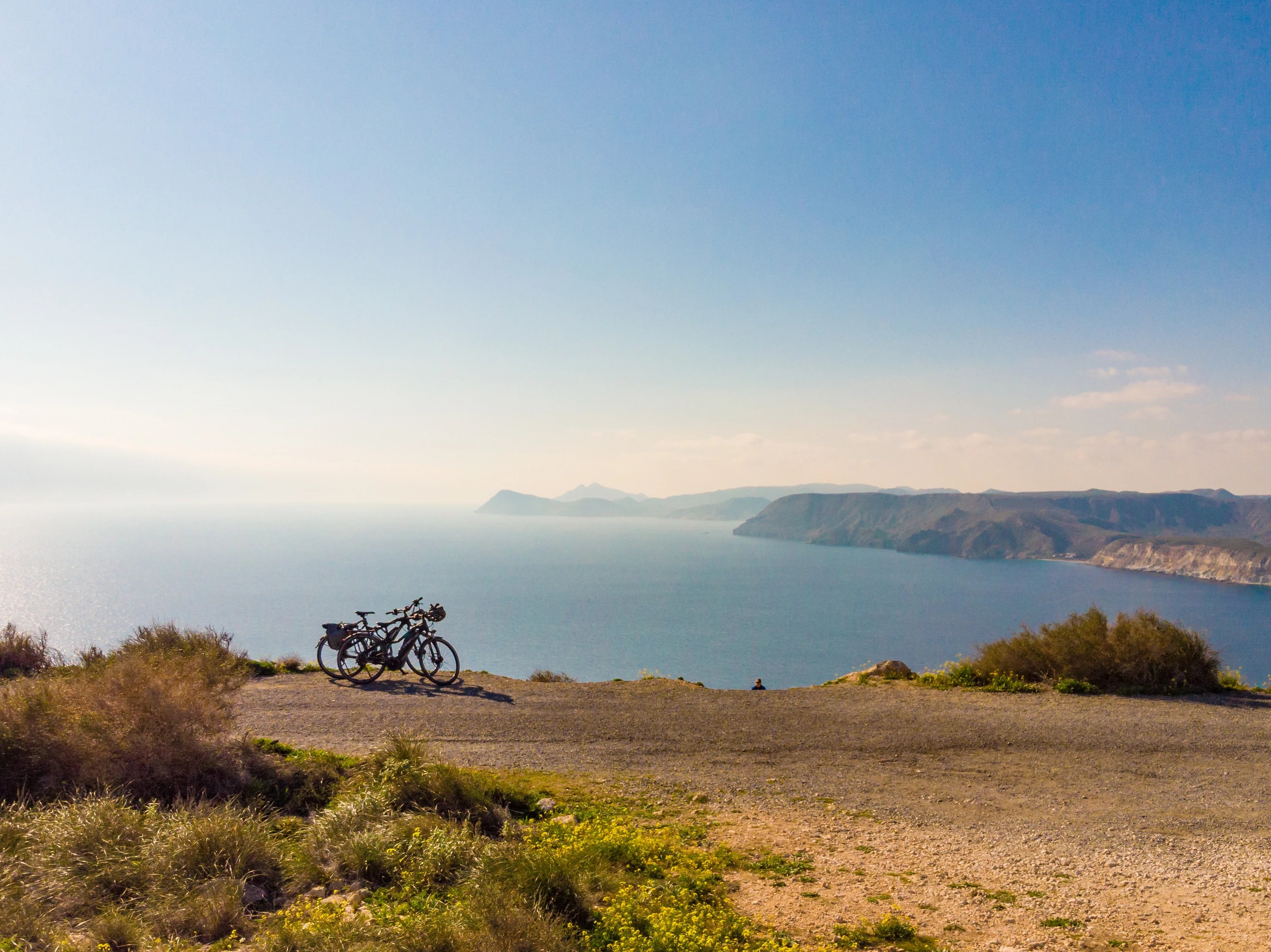
We take care of the essentials so your trip runs smoothly:
- A coherent route flow across provinces with well-balanced daily distances
- Comfortable rural hotels placed at natural stopping points
- Reliable luggage transfers between towns with narrow streets and limited access
- Accurate GPX files for quieter lanes where signage varies
- Season-aware planning that considers heat, wind, and local conditions
With these elements handled, you can simply enjoy the riding while everything behind the scenes works as it should.
Ready to Ride?

The Antequera–Seville journey showcases Andalusia’s landscapes, heritage, and quiet rural roads in a steady, rewarding week — ideal for riders who want culture, variety, and stress-free logistics.
For more inspiration, explore our full Andalusian cycling tour offering. When you’re ready to plan your trip, get in touch and we’ll tailor the perfect route to your pace, preferences, and travel dates.

Hassle-Free
We handle itineraries, accommodations, and anything else you prefer not to deal with, so you can enjoy a carefree holiday.

Completely Customizable
Flexibility is our middle name — whether you want more or less, or just beyond ordinary, we’ll make it happen.

Book with confidence
We are a financially protected company, fully bonded and insured, keeping your money safe and allowing you to travel with confidence.

Unbeatable support
Our 24/7 customer support is where we show our passion, bringing you a better experience by making your well-being our number one priority.
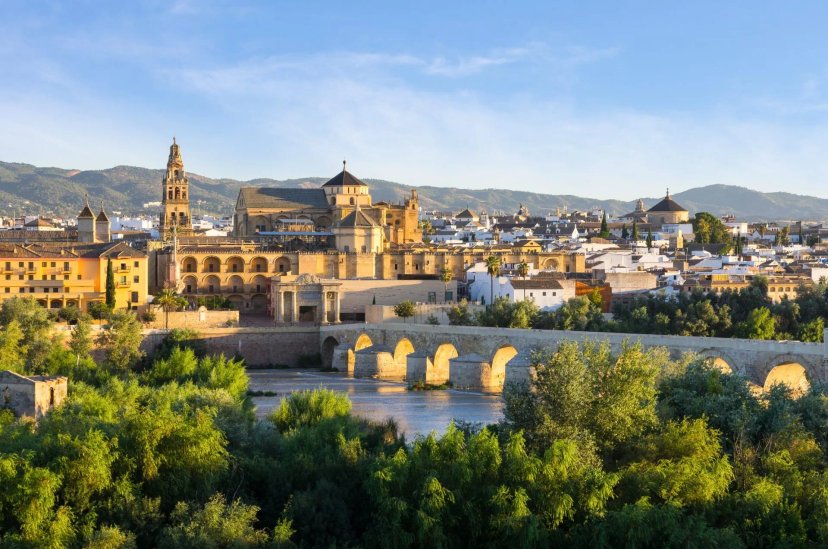
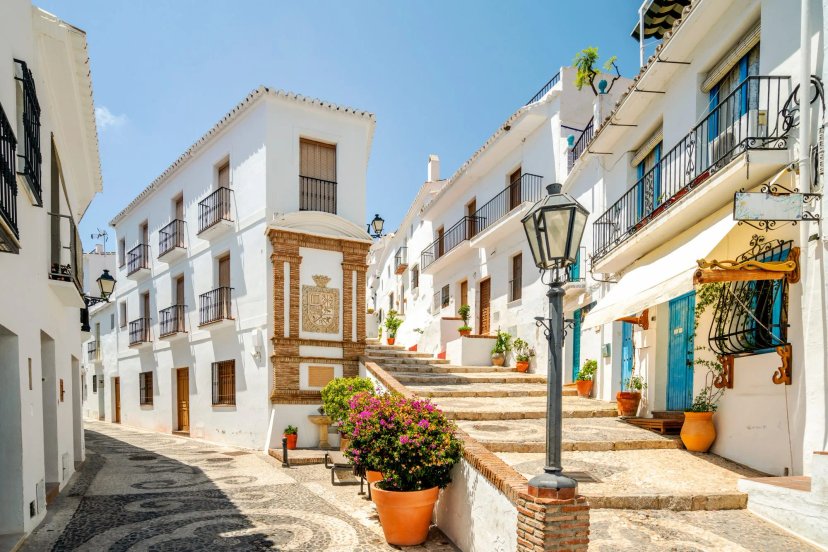

.jpg&w=3840&q=75)
